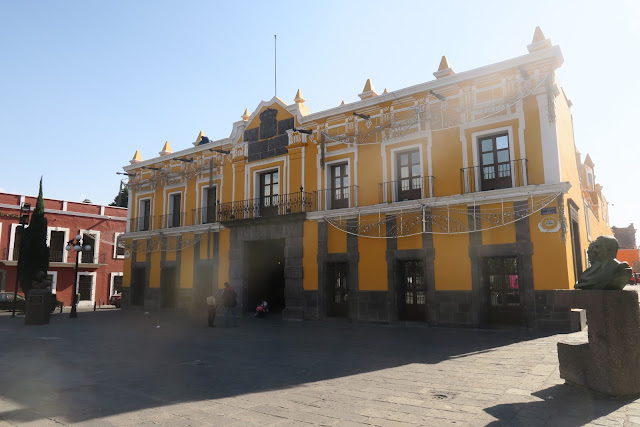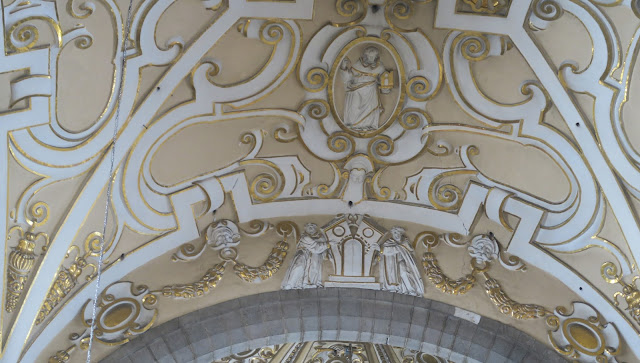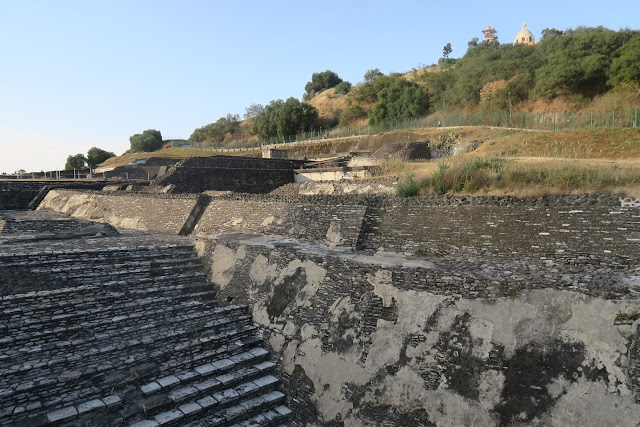A French War, A Solution to the Graffiti Problem, Two Tunnels and the Charms of Old Puebla
Méson Sacristía de la Compañía, A Characterful Hotel
In Puebla we stayed at the Méson Sacristía de la Compañía, a boutique hotel in the heart of the old town.
 |
| Meson Sacristia de la Compania, Peubla |
A colonial building, the atrium is also the restaurant and our room opened onto the gallery above.
 |
| The Atrium, Meson Sacristia de la Compania, the door to our room is on the gallery, top left |
The room had character. Photographing your bathroom door would generally be considered eccentric, but not (perhaps) when it is a solid slab of wood set in a Talavera tiled wall.
 |
| Probably the first bathroom door I have ever photographed, Meson Sacristia de la Compania |
For breakfast we ate huevos rancheros in the atrium. I had been looking forward to this Mexican speciality but found it as disappointing as last night’s mole poblano. Two fried eggs sitting on a tortilla had been hosed down in a thin sauce, its main contribution being to make the tortilla soggy. A dump of the ubiquitous black beans topped with slices of avocado completed the ensemble. Lynne eschewed the tortilla, soggy or not she had decided that corn-based foods were not for her; fortunately there was also fruit and bread and jam so nobody went hungry.
Fort Loreto Park and the Battle of Cinco de Mayo, Puebla
G was a little late. As the first picture shows, workman were busy stringing up Christmas lights, and the street had been closed to traffic, so he had to park further away and walk.
He drove us up to the Fort Loreto Park where there are views over the city, and even a distant sight of Popocatepetl – G’s pronunciation gave this already magnificent word a lilt I wish I could imitate. It is somewhere in the picture, hiding in the mist (the mountain, not the lilt).
 |
| Puebla from Fort Loreto Park |
The park occupies the site of the Battle of the 5th of May. We prefer to name battles after their location, it is more informative (maybe, but where are Blenheim and Malplaquet?) while Cinco de Mayo tells us only that the battle took place in spring, offering no clue as to where, in what war and between whom. G clearly thought the battle a big deal so I decided not to mention that I had never heard of it, nor of the war of which it was part.
Cinco de Mayo is a public holiday in Puebla State and is widely observed in the USA as a day of celebration of Mexican culture. In North Staffordshire the date tends to pass without comment. The park contains some of the floats used in the annual procession, like this model of the Monumento a la Revolución in Mexico City.
 |
| Model of the Monumento de la Revolucion, Fort Loreto Park, Puebla |
Mexico had hardly recovered from the Mexican-American War (1846-8) when a civil war broke out (the Reform War 1858-60). The government ran out of money and in 1861 President Benito Juárez declared a two-year moratorium on the repayment of foreign debt. The main creditors, Britain, France and Spain, sent fleets to Veracruz. The British and Spanish withdrew after negotiations, but Napoleon III saw an opportunity for a French influenced Mexican Empire.
In late 1861 a French army stormed Veracruz and marched on Mexico City. On the 5th of May 1862, at Puebla, they attacked a smaller, poorly equipped Mexican force. Misled into believing they had the support of the townspeople the French assault was badly organised and over-confident and the result was a crushing Mexican victory.
 |
| Veracruz is a major port on the Gulf of Mexico at the same latitude as Puebla |
The victory did a great deal for Mexico’s national self-esteem, but little to alter the course of the war. In July 1863 Maximilian, Napoleon III’s nominee and the younger brother of Franz Joseph I of Austria, became Emperor Maximilian I of the Second Mexican Empire.
His empire did not endure. Looming war with Prussia led to French forces being withdrawn in 1866, while the Americans, no longer distracted by their own civil war, sent aid to Benito Juárez and his government in exile, hiding out in Northern Mexico.
The Empire collapsed within a year and Maximilian was executed on the 19th of June 1867.
Xanentla and a Solution to Mexico's Graffiti Problem
Leaving the park, G drove us down to the suburb of Xanenetla. Mexico has a graffiti problem, but Xanenetla has a novel solution; the whitewashed walls of the dwellings have been given over to street artists.
 |
| Xanenetla, Puebla |
The styles are many, ...
 |
| Painted houses, Xanenetla, Puebla |
…the colours bright and varied,…
 |
| Painted houses, Xanenetla, Puebla |
…as are the choices of subject.
 |
| Pandas, Xanenetla, Puebla |
Sadly there is a little evidence that this is not a complete solution.
 |
| Painted houses and some graffiti, Xanenetla, Puebla |
Puebla's 'Secret' Tunnels
‘Secret tunnels’ make frequent appearances in adventure books for children, but rarely actually exist. The secret tunnels beneath Puebla were long regarded as urban legend until their rediscovery in 2015. Several hundred metres of tunnel lead from near Xanenetla back towards Fort Loreto. Large enough to accommodate horses as well as men, the tunnel was probably built by the conquistadors in the 1530s to move church treasure in times of danger and may later have played a part on the events of the 5th of May 1862. No longer secret and now carefully restored, we walked its length inspecting the exhibitions of horseshoes, tools and other detritus left by the original users.
 |
| The no longer 'secret' tunnels of Puebla |
We emerged in another tidy suburb and waited while G fetched the car, before driving us back into town.
 |
| A brief wait while G fetched the car, Puebla |
Street Food and Another Tunnel, Puebla
Lunchtime had arrived and G’s brief was to show us the street food of Puebla. Accepting this would involve corn dough we approached a young man with a plastic basket stuffed with tiny, warm tacos folded round a vegetable paste. They were pleasant, if a rather bland before the addition of chilli sauce and onion.
 |
| G offers Lynne a tiny taco |
After our starter we dropped down into another ‘secret’ tunnel - nobody knows how many are awaiting discovery, but informed speculation suggests they may stretch for 10km below the city. We followed the river that once flowed above ground through the city centre, passing several old bridges. The river is now a sewer and we gratefully left this pungent hole in the earth to emerge in Puebla’s artistic quarter.
 |
| The pungent tunnel under central Puebla and an old bridge |
Puebla's Artists Quarter
Puebla (in full, Heroica Puebla de Zaragoza for Ignacio Zaragoza who led the Mexican forces on the Cinco de Mayo) was previously called Puebla de los Angeles, and angels are still made welcome.
 |
| My wife is often mistaken for an angel, Puebla |
Tortillas, large blue ones, were cooking on a roadside hotplate. Blue corn cobs look odd but taste the same as the familiar yellow and, except for the colour, their dough is identical. Once ready they were smeared with salsa roja and salsa verde – half green, half red like the Mexican flag - a slick of sour cream was added, followed by a sprinkle of cheese and finally some grated onion.
 |
| Our main course is prepared, Puebla |
The result was not unpleasant, but I had hoped for something exciting, and this was not it. Eventually the weight of corn dough, lying in my unaccustomed stomach like a lead ingot, defeated me, though I ate more than Lynne.
I hate to be an Eeyore, and I am far from the Brit abroad reluctant to venture beyond omelette/steak ‘n’ chips, but I did not understand what they were trying to do. I love strong flavours, but the salsas were watery and underpowered and having made the tortilla soggy with salsa they piled on yet more wet ingredients. And what is the point of Mexican cheese? Why does it not taste of anything?
 |
| Lynne and a patriotic tortilla, Puebla |
As we ambled through the artist’s quarter, G suggested we pause for a drink. Two 30cl bottles for 30 Pesos (£1.20) was the attractive lunchtime offer so I bought four bottles between the three of us. Mexican yellow lager is nothing special – Corona’s worldwide popularity is a triumph of marketing over substance – but they brew some more characterful ‘Vienna-style’ dark lagers. On this occasion we enjoyed Dos Equis Ambar, but at other times appreciated Bohemia and Victoria.
 |
| Artist's quarter, Puebla |
Puebla's Centro Historico
Those who linger too long at the café tables might forget where they are, so the city fathers have kindly erected a large reminder nearby.
 |
| Where am I? |
Teatro Principal
The building behind, the Teatro Principal,….
 |
| Teatro Principal, Peubla |
…is described as the oldest ‘active theatre space’ in America. The theatre was built in 1742 but has since burnt down and twice been rebuilt – though it occupies the same ‘space’. It still has the royal box once used by the unfortunate Maximilian I, though the theatre has been rebuilt since his time!
 |
| Inside the Teatro Principal, Puebla |
Some Novel Ice Cream Flavours
After a lunch dominated by corn dough we were relieved when G suggested ice-cream for a mid-afternoon snack and selected a shop offering a wide choice of flavours, some of them a little odd (cheese ice-cream, anyone?). We could translate most, G helped out with several more, but even he could not render Maracuyá or Guanabana into English, so that was what we chose.
 |
| Ice-cream choices, Puebla |
The ice-cream was good quality, both flavours were enjoyed and although maracuyá was familiar we could not quite place it. Guanabana remained a mystery. [Maracuyá, we learnt later, is passion fruit, so we should have recognised it, guanabana is soursop. No, nor me. Wikipedia says it is a spikey, vaguely pear-shaped fruit that grows on an evergreen tree widespread in tropical parts of the Americas. Its flavour is a combination of strawberry and apple with a sour citrus note. I have never seen one, but it makes a good ice-cream.]
 |
| Eating ice-cream in Puebla |
We wandered along the street, dropping into several sweet shops for a taste of the sweeties and, in one, a tot of mezcal (of which more in a future post), a more interesting spirit than the better-known tequila.
The Church of Santo Domingo
The Church of San Domingo, originally the church of the Dominican Monastery, was built between 1571 and 1611 (or 1659, depending on source).
 |
| The Rosary Chapel of Santo Domingo, Puebla |
The reredos is covered with statues of saints….
 |
| Reredos, Santo Domingo, Puebla |
…but on the arch in front of the altar are two stucco faces, apparently of Don Quixote. In 1605, 262 copies of Cervantes’ newly published book arrived in Veracruz and it is believed that plasterwork specialist Pedro García Durango chose to incorporate this homage. It is believed to be the only depiction of a character from a novel in the fabric of any Catholic Church.
 |
| The stucco on the arch with two depictions of Don Quixote, Santo Domingo, Puebla |
The Rosary Chapel was added between 1650 and 1690 in New Spanish Baroque.
 |
| Dome of the Rosary Chapel, Santo Domingo, Puebla |
At the time it was hailed as the 8th Wonder of the World and it is certainly impressive, if a little over the top. As many others have found the overhead lighting and reflective surfaces make the altar difficult to photograph (though there was no problem with the ceiling).
 |
| Altar, Rosary Chapel, Santo Domingo, Puebla |
Outside, in Av Cinco de Mayo (what else?), shaded by huge, trees feels like an enclosed arcade.
 |
| Av Cinco de Mayo, Puebla |
Zòcalo and the Cathedral
The avenue ends at the zòcalo, the main square, with the early 20th century Municipal Palace (Town Hall)…
 |
| Municipal Palace, Puebla |
…while opposite, behind a small wooded park, is the cathedral. Started in 1575, it was consecrated in 1649, though it was not finished until 1768 which explains why the façade is transitional between late baroque and neo-classical.
 |
| The façade of Puebla cathedral |
The interior is large, complex and confusing, with five naves and five altars, one hexagonal central altar (a clear line of sight for a photograph was impossible) and four more facing in the cardinal directions.
 |
| One of the non-hexagonal altars, Puebla Cathedral |
Earthquake Damage
With G, a full day’s tour had meant exactly what it said, but now it was time to head back to our hotel. In my photographs the streets of Pueblo look clean, uncluttered and pleasantly relaxed. That is a fair reflection (though if you want to find traffic you can), but Puebla suffered in the September earthquake, there was much scaffolding inside the cathedral and it was not hard to find closed roads and buildings supported by props.
 |
| Earthquake damage, Puebla |
A Regrettable Dinner
Back at our hotel we found the Christmas lights had been strung up but were not yet operational so we walked down to find dinner in the gloom.
 |
| The Christmas lights are up, but not on, Puebla |
The only open restaurant was the place we lunched yesterday. Inside there was no heating, at 2,000m+ Puebla gets cold once the sun goes down, and no other customers. Lynne thought she could manage nachos with cheese and beans while I had egg, sausage and beans – the distinctively Mexican version of scrambled eggs, salchichas and black beans, so not quite as all day English breakfast as it sounds. We thought we had made a poor choice of venue even before the youthful waiter tried to short change us; it was an amateurish attempt and he backed down as soon as confronted.
It was not a comfortable night, the lunchtime tortillas made themselves felt, but an Imodium was sufficient to solve the problem.
South East from Mexico City
Part 2: Mexico City (2) Centro Historico and Teotihuacan
Part 3: Cholula, a Big Pyramid and Fresh Grasshoppers
Part 4: Puebla, Cinco de Mayo and Street Food
Part 5: Oaxaca (1): Monte Alban
Part 6: Oaxaca (2): Cooking a Mole
Part 7: San Cristóbal de las Casas. Chamula and Zinacantán
Part 8: The Sumidero Canyon and Chiapa de Corzo
Part 9: San Cristóbal to Palenque via Toniná
Part 10: Palenque and Back to Mexico City
Part 11: Mexico City (3) Kahlo, Rivera and Trotsky
THE END



.jpg)


















